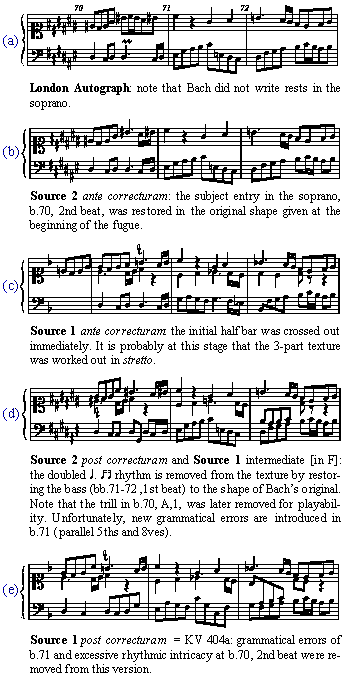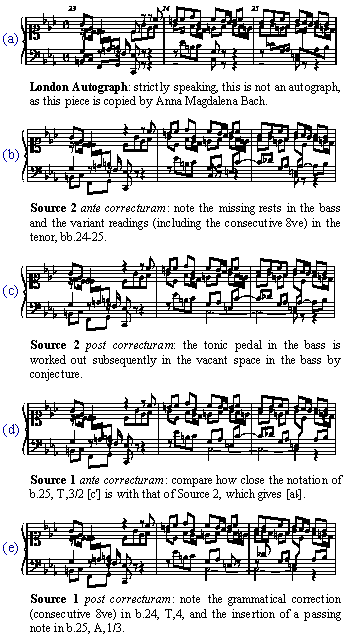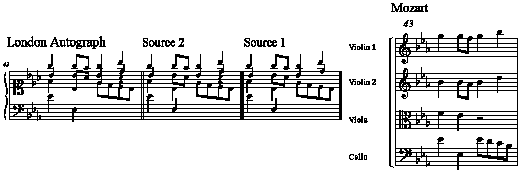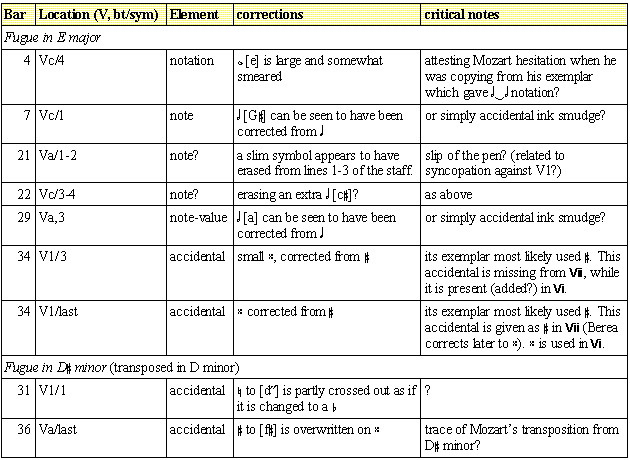
One of the most tempting questions would be like this one: "Did Mozart perform the pieces from WTC in one of these concert tours?" Answering this shall have to be put aside for future research topic for the moment. One thing we can say is that Mozart never mentioned 'WTC' directly in his letters although in the last 10 years of his life he copied the fugues from the collection, and therefore we can safely assume that he played them.(4)
The earliest known documentary evidence for Mozart's acquaintance with the fugues of J. S. Bach, possibly taken from WTC, is associated with Gottfried van Swieten who served as Austrian envoy to the court of Frederick the Great in Berlin from 1770 to 1777, and is known to have brought back a number of Bach manuscripts to Vienna.(5)
We learn from Mozart's letters from 1782, soon after he moved to Vienna, that his encounter with the works of Bach and Handel was something that he thought it was worth reporting to his families. In his letter to his father on 10 April 1782, he writes:
"... I go every Sunday at twelve o'clock to the Baron van Swieten, where nothing is played but Handel and Bach. I am collecting at the moment the fugues of Bach not only of Sebastian, but also of Emanuel and Friedemann". (6)Then, 10 days later, he writes to his sister also, in a letter which accompanies his own "prelude and a three-part fugue" KV 394. In it he mentions Bach once again in the same context. He writes:
"My dear Constanze is really the cause of this fugue's coming into the world. The Baron van Swieten, to whom I go every Sunday, gave me all the works of Handel and Sebastian Bach to take home with me (after I had played them to him). When she will listen to nothing but fugues, and particularly (in this kind of composition) the works of Handel and Bach."(7)These letters of a 26-year-old man inform us of his happy and fortunate moments of his life, and the way he reports tells us how much Mozart was excited about his new married environment, new friendship at Swieten's where he met several enthusiasts whose special interest was the music of the Baroque masters.(8)
"If Papa has not yet had those works by Eberlin copied, so much the better, for in the meantime I have got hold of them and now I see (for I had forgotten them) that they are unfortunately far too trivial to deserve a place beside Handel and Bach. With due respect for his four-part composition I may say that his clavier fugues are nothing but long-drawn-out voluntaries."(9)Here we can read that Mozart judged the music of Handel and Bach with his memory of Eberlin's fugues which he had played in his childhood and at present.
There are, of course, other minor possibilities as to who else could have brought the works of Sebasian Bach into Vienna or to Mozart personally. There are several other possible links.
On 6 December 1783 Mozart writes to his father asking for Bach's fugues among other pieces, which he repeats on the 24th in a more desperate, begging manner. It is most probable that this refers to his own manuscripts (KV 405) made under van Swieten which he brought with him to Salzburg in the summer of 1783 and left there, and not a manuscript copy of the WTC.(10) However, there is also room to speculate that this might have been a totally different manuscript in his father's collection. It is not known what course of action had followed this, but we find no further references to Bach's fugues after these letters in this connection.
His piano pupil, Prince Carl Lichnovsky (b. 21 July 1761) is another connection who might have supplied the pieces from WTC to Mozart. Lichnovsky studied at Göttingen, where Bach's first biographer, J. N. Forkel was the director of music at the university. It is natural to assume that Lichnovsky brought back some copies of Bach's keyboard works to Vienna, including the famous WTC.(11)
And of course, we should not forget J. G. Albrechtsberger who moved to Vienna in 1772. Future study of all these links is highly desirable as to trace the origins of textual contamination as a result of source comparison, for Vienna Bach sources suffer much from this very editorial activity as I shall come back to explain later.
Although no further details are known about the pieces performed in van Swieten circle, one can easily make an assumption that a series of fugue arrangements for stringed instruments surviving to this day can be a part of them. Interestingly, Mozart's autograph is among them, and there survives no keyboard version in Mozart's handwriting. They are shown in Tables 1 - 4:
|
|
|
|
|
|
|
|
|
|
|
|
|
|
|
|
|
|
|
|
|
|
|
|
|
|
|
|
||
|
|
|
|
|
|
|
|
|
|
|
|
|
|
|
|
|
|
|
|
|
|
|
|
|
|
|
|
|
|
|
|
|
|
|
|
|
|
|
|
|
|
|
|
|
|
|
|
|
|
|
|
|
|
|
|
|
|
|
|
|
|
|
As there is no mention of the arranger, there is no firm evidence to suggest that all except one in Mozart's own handwriting is related to Mozart. In fact all the earlier scholars tended to consider seriously Mozart's involvement with all the arrangement above without adequate foundation.(18) The question is still open as to who was responsible for transcription, transposition, let alone composing the anonymous introductions.
Furthermore Einstein's claim that "Mozart arranged and re-wrote for these Sunday mornings [at Swieten's], which were at first Trio, then Quartet matinées",(19) referring to KV 404a and 405, is also without foundation. In fact I am going to show the evidence against this common belief that KV 404a dates later than KV 405. I say this without any implication of their authorship.
In the past, the sheer number of variants of diverse musical quality has been the major obstacle in fair understanding of these string arrangements. In his paper read in Prague 1956, Walther Vetter attempts to justify how the majority of the major variant readings in KV 404a could be attributed to Mozart in the light of their inheritance of the spirit from the Rococo and Classical Era.
He cannot be wrong in saying that "Mozart had no intention in mechanical transcription, working from Bach's keyboard setting to string arrangement."(20) However, it seems he went a little too far when he generalises the issue and attributes these variants to Mozart saying that "Mozart showed clearly his unique identity partly intentionally and tactually, and partly purely intuitively."(21) This can of course be a possibility for Mozart, but not always the case, especially our case, as later scholars found.
The crucial misfortune for Vetter was the lack of information he had on source issues. It was pity that his discussion of the variants in KV 404a was based on the sole supposition that Mozart's Vorlage was the authentic version of Bach's, and that Mozart had demonstrated what he was capable of. Thus when he comes to discuss specific textual matters, he has no other way but to compare two remote readings without taking into consideration the processes of textual metamorphosis. In other words, he made little allowance for intermediate corruptions or contamination to the Vorlage used by Mozart.
The problem associated with this kind of generalised assessment of individual variants from grammatical, historical and artistic quality is that there are so many ways to argue their origin or to justify their value. Although we cannot be too wrong about what we say as long as it makes sense in the right context, our ultimate aim is the precise scientific description of the historical facts. Thus we should be aware of this inherent obscurity with regard to the assessment of variant readings.
The major breakthrough was achieved by the study of a Bach manuscript in USA in the early 1960s,(22) which consists of 24 fugues of WTC II, without preludes. In their respective articles, Andreas Holschneider and Warren Kirkendale discuss the Bach manuscript in the Ritter Library at Baldwin-Wallace College, Berea, Ohio as the possible Vorlage for KV 404a and 405. Their claim appears to be based on the fact that:
"A comparison of the deviations from Bach's text in KV 404a, KV 405, and the anonymous quartet arrangements with the Berea manuscript leaves little doubt that this manuscript was used for all three sets of arrangements a further indication that it belonged to Van Swieten."(23)Kirkendale, and subsequently Gerhard Croll, refute that the conclusions reached by earlier scholars, namely, with respect to KV 405 by Einstein and KV 404a by Vetter, that the textual deviations found in Mozart's arrangements originate in "Mozart's own creative act."(24)
There were predicaments in the approaches of the sixties, however. The concerns were two-fold the lack of information and the inadequate handling of information. On the one hand, it can be seen that the lack of source-related information severely hampered the well-substantiated study to be conducted on the Berea manuscript. On the other hand, no study was carried out as to how the numerous variant readings and errors were introduced to the Berea manuscript. The fact that at least Mozart's own version of fugue arrangement did not inherit numerous pitch errors and other minor corruptions found in the Berea manuscript should have been sufficient to suggest that it could not have been Mozart's Vorlage.
As a result, the relationship between the Berea manuscript and KV 404a and 405 was not established with clear, fair arguments. From other angles, it can be said that the positive textual and physical information, which supported their close relationship, and the negative information which argues against their relationship, were not justly handled.(25) If this text-critical study were conducted fairly, it would have been possible to suppose that there were at least several intermediate sources closely related to the Berea manuscript where the origins of numerous textual manipulation and corruption can be traced which again could have had a similar chance of being used by Mozart. I will come back to address what kind of predicament their approach will have for this type of source study after the discussion of the contribution of the recent Bach studies.
Recent Bach source studies identified five further sources which are closely related to the Berea manuscript.(27) This group of sources has many common aspects errors, variant readings, and above all, they appear as a chiefly fugue-only collection of WTC II. They are:
|
|
|
|
|
|
|
|
|
|
|
|
|
|
|
|
|
|
|
|
|
|
|
|
|
|
|
|
|
|
|
|
|
|
|
The major difference between these two branches of Viennese Bach sources namely that the former consists of one prelude and 16 fugues, some of which are transposed,(29) and the latter contains all the 24 fugues in the original key(30) -- can be considered as the difference in philosophy behind collections compiled from the same origin. They also diverge in other minor aspects (e.g., notational policies and other unique minor variants), but this cannot invalidate the central hypothesis that they originated in the same manuscript in Berlin.
Interestingly, both sources contain numerous revisions in several layers. Closer examination on the original MSS reveals that some of the revised readings are the result of detailed comparison between the sources themselves. This type of revised readings ranges from the correction of errors (such as Fg.c, b.21, B,4 from a crotchet [g] to a quaver + 2 semiquaver [g a b]) to the introduction of unique variant readings some of which are sometimes slightly corrupt (see Example 1 (d) and Example 2 (b) below).

There are also many occasions where certain revisions are made to only one of the two branches. For Source 1, the correction of errors are often observed in the pieces which are transposed from Bach's original keys,(31) and the introduction of unique, inspired and grammatically correct variant readings are worked out as later revisions (see Example 1 (e) above). As these unique later readings of 3-part fugues are also found in KV 404a, Source 1 could only be the Vorlage of KV 404a and not Source 2 or Source 3 that is claimed by Kirkendale and Holschneider.(32)
As for the 4-part fugues, the situation is very similar. The only marked difference is the fact that many of the unique revisions carried out in Source 1 did not find their way into KV 405 (see Example 2 (e) below), further suggesting that KV 405 was chronologically earlier than KV 404a. Moreover, the fact that some of the unique readings, both unchanged (e.g., Fg.Eb, b.54, A,1-2) and revised (e.g., Fg.E, b.30, S,3-4) in Source 1, are present in the anonymous arrangement of 4-part fugues, and not in KV 405, can be considered as the chronological evidence for the relationship of the two sets of string arrangements. What is clear from the study of revisions in Source 1 is that the variant readings are worked out here on this manuscript in many layers, from the early variant readings of the Vienna Bach Tradition to the later ones found in the anonymous string arrangements.
As for Source 2, the revisions can also be classified into two: one
correcting copying mistakes (mainly pitch errors in 2nd or 3rd of careless
origin which are nothing to do with the transcriptions),(33)
or the change of text from Bach's readings to the unique reading of Viennese
sources. In one instance, the involvement of Albrechtsberger, the scribe
of Source 1, is clearly visible in Source 2 where missing bars of Fg.E,
bb.21-23 are added later to the end of the movement. Unlike Source 1, the
layers of revisions seem to be narrower in chronological span.
Yet even if we exclude all the revised readings and focus on more discernible
characteristics of Vienna Bach Tradition as a whole, we are still overwhelmed
by the numerous textual errors of various kinds, as well as presenting
unique, sometimes surprisingly competent, variant readings.

Such departures are particularly numerous in the sub-group of Source 2 (referred to as Vii). Further study of these valid variant readings suggests that these unique readings are a part of conjectural revision activity presumably carried out in V', where voice-texture is reduced, where rests, which are needed to clarify the voice-texture, were presumably missing. It is also worth noting that the notational representation, such as the use of accidentals and the use of the upper and lower system, is often different between the two sources, suggesting that this aspect of the score is freely and systematically overhauled by the scribe.
Based on all the above observations, I am inclined to conclude that Source 2, the collection of 24 fugues, was copied initially independently of Albrechtsberger's own collection of Bach's fugues to be the first bound Handexemplar of Bach's fugues in Vienna. While the scribe of Source 2 had freedom to change minor notational details, he introduced numerous errors in his copy. Albrechtsberger then edited Source 2 together with his own manuscript as if he had been a supervisor of this project and corrected errors in Source 2 wherever he finds there. This correction was not a systematic, but sporadic, looking for particular passages that he found interested in improving the pieces. The variant readings whose revision process can be traced in neither Albrechtsberger's own manuscript nor Source 2 indicates that a similar revision process was carried out in their common Vorlage. Apart from the above mentioned attempted 'repair' of a missing voice, the consistent supplement of ties to Fg.F# and slurs to Fg.Bb can also be included in this category of editorial activity.
Source 3 belongs to the source group V''' which stemmed from a late stage of revision in Source 2: while it contains most of the unique readings and notational features, it attempts to improve some notational aspects (e.g., modification from "two tied crotchet" to "a minim") and at the same time, introduces new errors / variants as a result of copying errors (e.g., Fg.C, b.38, S,2 as a crotchet [d''] instead of two quavers [d'' f'] in Source 2). This group of manuscripts originates in a scribe whose task was to make multiple copies while making a better, more readable musical text than that of Source 2. Two MSS are known to have survived: Source 3 and Source 4. Federhofer (title page and the first page of Fg.C) can be considered as part of V'''.The other leaf of Federhofer, containing Fg.B (transposed to C major), stems from Vi.
The last item, Source 6, is a thick bound miscellany of MSS of 129 folia containing various keyboard music by several different composers. The manuscript is, however, almost completely occupied by the movements from WTC II in random order. While the detailed description of this manuscript will have be put aside for a separate occasion, it is sufficient for this paper to mention that the textual origin of some gatherings can safely be trace back to the Vorlage of Source 2 and Source 1. The presence of preludes in the same gathering gives rise to a theory that van Swieten indeed brought back WTC II to Vienna, and not just the fugues. The majority of the leaves are heavily revised and annotated by several later hands in the 1840s using one of the printed editions, possibly by Czerny.(34)
The detailed comparison of the text with the extant Vienese Bach sources strongly suggests that Mozart's arrangement was made from the lost manuscript, which can be the source used by Albrechtsberger and the anonymous scribe who wrote Source 2. The evidence is the following:
In the light of this new study, the classification of unique readings presented in Kirkendale's edition of KV 405 requires slight revision, in which he classifies them as follows:(35)


This again warns us that there is a potential danger in assessing variants, and we should always look at them from many different angles.
And one of the items in "diverse alterations", the note duration doubled at the end of a phrase should also be considered as a part of "Adaptation for the string arrangements"
What is yet to be added to the list for our consideration is the notational preferences Mozart has consistently applied: they are the rhythmic notation using dots instead of ties (e.g., "dotted crotchet plus two semiquavers" instead of "crotchet tied to a beamed quaver plus two semiquavers") and the application of further cautionary accidentals than those already supplied in the presumed lost common Vorlage. These are the clearest proof of how Mozart copied music not mechanically but digesting the rhythmic flow of the line together with the harmony.
Thus the following amended list is categorised from Mozart's point of view as to how the variants could have been desired:
For if a fugue is not played slowly, the ear cannot clearly distinguish the theme when it comes in and consequently the effect is entirely missed.(36)

